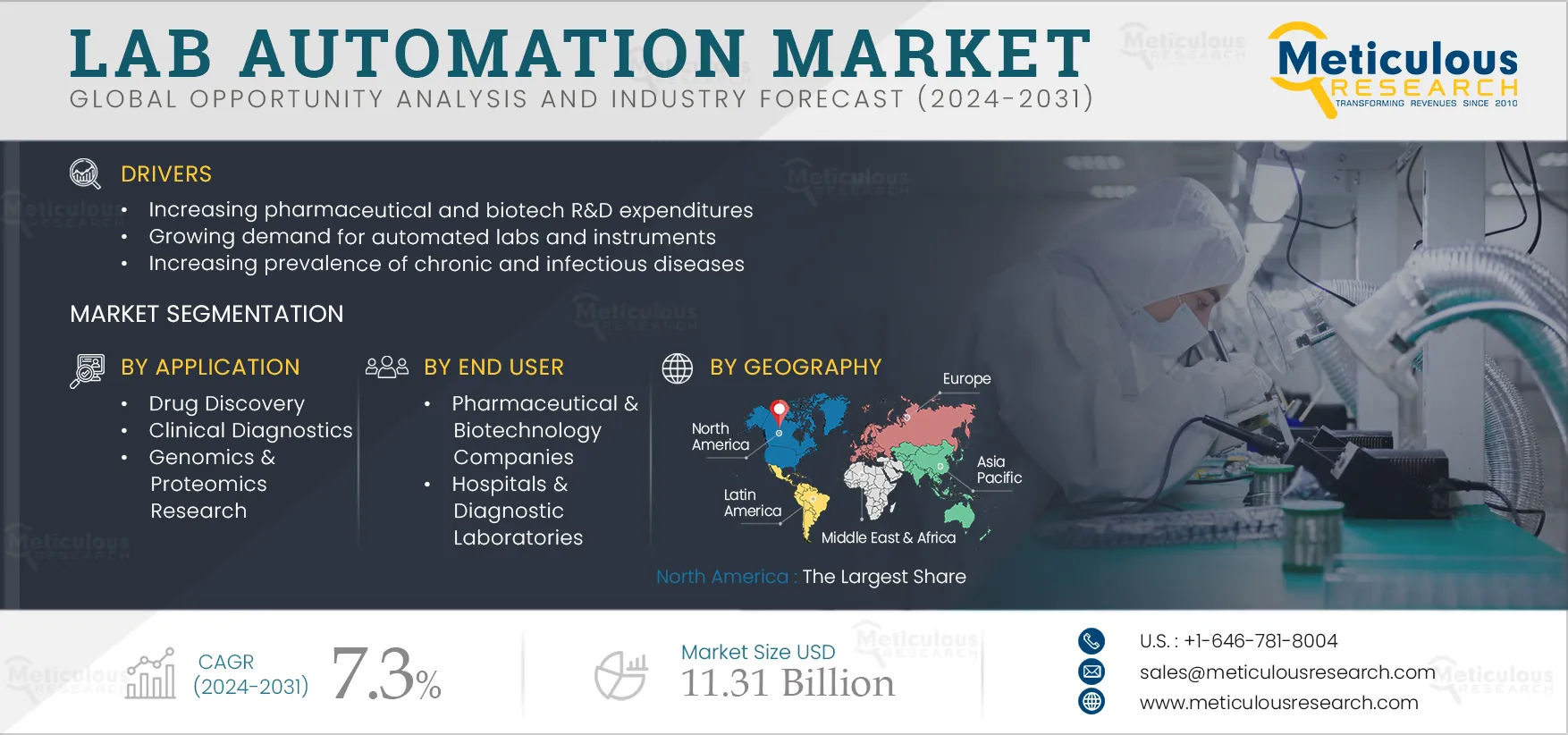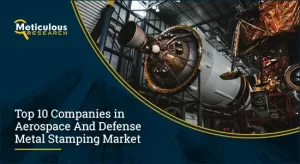
The Lab Automation Market was valued at $6.48 billion in 2023 and is projected to grow to $11.31 billion by 2031. Starting from an estimated value of $6.91 billion in 2024, this market is anticipated to expand at a compound annual growth rate (CAGR) of 7.3% during the forecast period from 2024 to 2031.
The Rise of Automated Laboratory Instruments: Transforming Workflows and Enhancing Efficiency
In recent years, the adoption of automated laboratory instruments has surged, driven by increasing pharmaceutical research and development (R&D) expenditures, a rise in chronic and infectious diseases, and a growing preference for automation among laboratories. This shift towards automation is primarily due to its capacity to manage complex tests and workflows, replace manual and repetitive tasks, increase throughput, and improve quality. This article delves into the myriad benefits of laboratory automation in both large and small laboratories, emphasizing how it streamlines workflows, enhances sample testing capabilities, and minimizes human error.
Download Sample Report Here: https://www.meticulousresearch.com/download-sample-report/cp_id=1221
Benefits of Laboratory Automation
Automated laboratories are equipped with cutting-edge systems and technologies designed to optimize various laboratory processes. By integrating automation into laboratory instruments, laboratories can significantly boost their capacity to process samples while reducing the reliance on manual methods and increasing accuracy. Automation incorporates robotics, computers, and sophisticated software to develop systems capable of performing numerous pre-analytical tasks, including storing, labeling, transporting, and centrifuging samples, ultimately preparing them for the analytical phase.
The laboratory sector has been grappling with staff shortages, which have negatively impacted the quality of care and efficiency. In response, existing employees often undergo cross-training in various laboratory disciplines to enhance flexibility and efficiency. This multi-training approach also helps staff take on additional responsibilities, such as overseeing safety and quality, as well as managing errors. According to the U.S. Bureau of Labor Statistics, the employment of laboratory technicians and technologists is projected to grow by 5% from 2022 to 2032, with around 24,000 job openings each year.
The implementation of laboratory automation has the potential to transform laboratories, enabling them to deliver faster and more accurate results while enhancing screening capabilities. This transformation leads to significant improvements in patient care and creates employment opportunities for qualified individuals.
Check complete table of contents with list of tables and figures: https://www.meticulousresearch.com/product/lab-automation-market-1221
Driving Forces Behind the Lab Automation Market
The growth of the lab automation market can be attributed to several factors, including the increasing prevalence of chronic and infectious diseases, heightened pharmaceutical R&D spending, and a growing demand for automated laboratories and instruments. These trends underscore the critical role of automation in modern laboratory settings.
High Growth Potential in Emerging Economies
Historically, laboratory automation was not widely adopted in emerging economies or developing countries like India, China, and Brazil. However, technological advancements and globalization have spurred the adoption of laboratory automation technologies in these regions. For example, pharmaceutical companies in India are increasingly leveraging lab automation technologies to enhance R&D, improve manufacturing processes, and ensure regulatory compliance. This shift not only enhances product quality and consistency but also improves working conditions.
In many African countries, high employee turnover rates result from skilled professionals migrating to Europe or America in search of better opportunities. This challenge has prompted many African nations to adopt laboratory automation, which requires fewer personnel to manage instruments and procedures. A notable instance is the CertaBlue System, introduced by Hersol Manufacturing Laboratories in South Africa in March 2022. This fully automated microbiological testing system significantly reduces assay completion times compared to manual processes, thus enhancing speed, efficiency, and product turnaround times.
Advancements in Laboratory Automation Through New Technologies
Laboratory automation has come a long way since its inception in the 1870s when it was first used to wash filtration residues automatically. The original automated instruments were often crafted by end-users due to a lack of available electrical components. Over time, however, the landscape evolved, leading to the introduction of automated clinical chemistry analyzers in the 1950s. This innovation paved the way for a rapid expansion of the lab automation market, resulting in the development of various automated instruments, such as automated liquid handling systems, automated immunoassay analyzers, and automated storage and retrieval systems.
Today, the incorporation of advanced technologies such as artificial intelligence (AI) and machine learning (ML) is revolutionizing laboratory automation. These solutions enhance data handling, improve decision-making, and facilitate more efficient operations. For instance, Synthace Ltd. in the U.K. has developed a cloud-based platform called Antha, which automates experimental design to optimize biological processes and assays. Antha analyzes historical data from previous experiments to propose trial experiments, resulting in improved efficiency and outcomes, including optimal reagent concentrations and reduced incubation times.
Unlocking Lab Automation: Insights from Market Analysis
Recent research from Meticulous Research offers valuable insights into the future trajectory of the lab automation market. Projections indicate a potential market value of $11.31 billion by 2031, with a notable compound annual growth rate (CAGR) of 7.3% from 2024 to 2031.
Significant trends are emerging as the lab automation market continues to evolve. By 2024, the technologies employed for lab automation are expected to play a crucial role, fueled by the increasing incidence of chronic and infectious diseases and rising investments in pharmaceutical and biotech R&D.
As the global landscape unfolds, North America is anticipated to maintain a substantial market share in 2024. Key industry players, including Thermo Fisher Scientific Inc., Abbott Laboratories, Danaher Corporation, Hamilton Company, and Siemens Healthineers AG, have established a strong presence across various regions, facilitating widespread adoption of lab automation solutions worldwide. This comprehensive overview from Meticulous Research provides a valuable gateway into the lab automation market, highlighting pivotal trends and contributors.
Quick Buy: https://www.meticulousresearch.com/Checkout/13937383
Conclusion
The growing demand for automated laboratories and instruments, coupled with increasing pharmaceutical and biotech R&D expenditures, has driven the adoption of lab automation across various countries. Additionally, advancements in technology—such as the integration of AI and ML to optimize workflows, the compact design of automated instruments, government initiatives, and the launch of new automated laboratories—are enhancing the significance and recognition of laboratory automation in today’s fast-paced environment. As laboratories continue to embrace automation, they stand to benefit from improved efficiency, accuracy, and overall productivity, ultimately leading to better outcomes for patients and healthcare systems alike.
Lab Automation Market Research Summary
| Particular | Details |
| Page No | 244 |
| Format | |
| Forecast Period | 2024-2031 |
| Base Year | 2023 |
| CAGR | 7.3% |
| Market Size (Value) | $11.31 billion |
| Market Size (Volume) | NA |
| Segments Covered | By Product
By Application
By End User
|
| Countries Covered | North America (U.S., Canada), Europe (Germany, France, U.K., Italy, Spain, RoE), Asia-Pacific (China, Japan, India, RoAPAC), Latin America, and the Middle East & Africa. |
| Key Companies | Thermo Fisher Scientific, Inc. (U.S.), Bio-Rad Laboratories, Inc. (U.S.), Danaher Corporation (U.S.), Revvity, Inc. (U.S.), Agilent Technologies, Inc. (U.S.), Waters Corporation (U.S.), Tecan Group Ltd. (Switzerland), F. Hoffmann-La Roche AG (Switzerland), Siemens Healthineers AG (Germany), Abbott Laboratories (U.S.), Becton, Dickinson, and Company (U.S.), Hudson Robotics, Inc. (U.S.), Hamilton Company (U.S.) |
About Meticulous Research®
Meticulous Research® is a leading provider of comprehensive market intelligence, offering actionable insights and analysis across various industries. Our reports empower businesses to make informed decisions, drive growth, and remain competitive in a rapidly evolving marketplace.
Contact Us:
Meticulous Market Research Pvt. Ltd.
1267 Willis St, Ste 200 Redding,
California, 96001, U.S.
USA: +1-646-781-8004
Europe : +44-203-868-8738
APAC: +91 744-7780008
Email- sales@meticulousresearch.com
Visit Our Website: https://www.meticulousresearch.com/
Connect with us on LinkedIn- https://www.linkedin.com/company/meticulous-research







